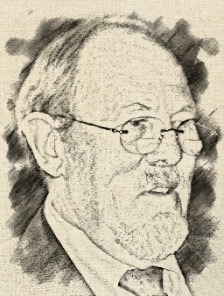|
Louis Bachelier
Louis Jean-Baptiste Alphonse Bachelier (March 11, 1870 – April 28, 1946) was a French mathematician at the turn of the 20th century. He is credited with being the first person to model the stochastic process now called Brownian motion, which was part of his PhD thesis The Theory of Speculation, (published 1900). His thesis, which discussed the use of Brownian motion to evaluate stock options, is historically the first paper to use advanced mathematics in the study of finance. March 29, 1900, is considered by many to be the day mathematical finance was born. On that day a French doctoral student, Louis Bachelier, successfully defended his thesis Théorie de la Spéculation at the Sorbonne. The jury, while noting that the topic was "far away from those usually considered by our candidates," appreciated its high degree of originality. This book provides a new translation, with commentary and background, of Bachelier's seminal work. Bachelier's thesis is a remarkable document on two counts. In mathematical terms Bachelier's achievement was to introduce many of the concepts of what is now known as stochastic analysis. His purpose, however, was to give a theory for the valuation of financial options. He came up with a formula that is both correct on its own terms and surprisingly close to the Nobel Prize-winning solution to the option pricing problem by Fischer Black, Myron Scholes, and Robert Merton in 1973, the first decisive advance since 1900. Aside from providing an accurate and accessible translation, this book traces the twin-track intellectual history of stochastic analysis and financial economics, starting with Bachelier in 1900 and ending in the 1980s when the theory of option pricing was substantially complete. The story is a curious one. The economic side of Bachelier's work was ignored until its rediscovery by financial economists more than fifty years later. Louis Bachelier performed the first rigorous analysis of stock market returns in his 1900 dissertation. This remarkable work documents statistical independence in stock returns—meaning that today’s return signals nothing about the sign or magnitude of tomorrow’s return—and this led him to model stock returns as a random walk, in anticipation of the later known as the Efficient Market Theory. Unfortunately, Bachelier’s work was largely ignored outside mathematics until the 1950s. The first pioneering contribution in the field of financial economics was made in the 1950s by Harry Markowitz who developed a theory for households' and firms' allocation of financial assets under uncertainty, the so-called theory of portfolio choice. This theory analyzes how wealth can be optimally invested in assets which differ in regard to their expected return and risk, and thereby also how risks can be reduced. A second significant contribution to the theory of financial economics occurred during the 1960s when a number of researchers, among whom William Sharpe was the leading figure, used Markowitz's portfolio theory as a basis for developing a theory of price formation for financial assets, the so-called Capital Asset Pricing Model, or CAPM. A third contribution to financial economics concerns the theory of corporate finance and the evaluation of firms on markets. The most important achievements in this field were made by Merton Miller, initially in collaboration with Franco Modigliani (who received the Alfred Nobel Memorial Prize in Economic Sciences in 1985 mainly for other contributions). This theory explains the relation (or lack of one) between firms' capital asset structure and dividend policy on one hand and their market value on the other. | ||||||
|
Harry Markowitz
Harry Markowitz (Aug. 24, 1927 - ) was born in Chicago, Illinois. He received his bachelor’s degree and Ph.D. in economics from the University of Chicago. Harry Markowitz received the Nobel Prize for Economics in 1990, along with William Sharp and Merton Miller, for their contributions to financial economics. In the 1950s Markowitz developed the Modern Portfolio Theory, which illustrates how investment risks in the financial market can have a maximized return. In 1952, Markowitz published his article “Portfolio Selection,” which explains his theory.
A Markowitz Efficient Portfolio is one where no added diversification can lower the portfolio's risk for a given return expectation (alternately, no additional expected return can be gained without increasing the risk of the portfolio). The Markowitz Efficient Frontier is the set of all portfolios that will give you the highest expected return for each given level of risk. These concepts of efficiency were essential to the development of the Capital Asset Pricing Model (CAPM). Financial markets serve a key purpose in a modern market economy by allocating productive resources among various areas of production. It is to a large extent through financial markets that saving in different sectors of the economy is transferred to firms for investments in buildings and machines. Financial markets also reflect firms' expected prospects and risks, which implies that risks can be spread and that savers and investors can acquire valuable information for their investment decisions. The contribution for which Harry Markowitz was first published in an essay entitled "Portfolio Selection" (1952), and later, more extensively, in his book, Portfolio Selection: Efficient Diversification (1959). The so-called theory of portfolio selection that was developed in this early work was originally a normative theory for investment managers, i.e., a theory for optimal investment of wealth in assets which differ in regard to their expected return and risk. On a general level, of course, investment managers and academic economists have long been aware of the necessity of taking returns as well as risk into account: "all the eggs should not be placed in the same basket". Markowitz's primary contribution consisted of developing a rigorously formulated, operational theory for portfolio selection under uncertainty - a theory which evolved into a foundation for further research in financial economics. Markowitz showed that under certain given conditions, an investor's portfolio choice can be reduced to balancing two dimensions, i.e., the expected return on the portfolio and its variance. Due to the possibility of reducing risk through diversification, the risk of the portfolio, measured as its variance, will depend not only on the individual variances of the return on different assets, but also on the pairwise co-variances of all assets. Hence, the essential aspect pertaining to the risk of an asset is not the risk of each asset in isolation, but the contribution of each asset to the risk of the aggregate portfolio. However, the "law of large numbers" is not wholly applicable to the diversification of risks in portfolio choice because the returns on different assets are correlated in practice. Thus, in general, risk cannot be totally eliminated, regardless of how many types of securities are represented in a portfolio. In this way, the complicated and multidimensional problem of portfolio choice with respect to a large number of different assets, each with varying properties, is reduced to a conceptually simple two-dimensional problem - known as mean-variance analysis. In an essay in 1956, Markowitz also showed how the problem of actually calculating the optimal portfolio could be solved. (In technical terms, this means that the analysis is formulated as a quadratic programming problem; the building blocks are a quadratic utility function, expected returns on the different assets, the variance and co-variance of the assets and the investor's budget restrictions.) The model has won wide acclaim due to its algebraic simplicity and suitability for empirical applications. Generally speaking, Markowitz's work on portfolio theory may be regarded as having established financial micro analysis as a respectable research area in economic analysis. He is best known for his pioneering work in modern portfolio theory, studying the effects of asset risk, return, correlation and diversification on probable investment portfolio returns. His efficient frontier concept was introduced in 1952 and is a cornerstone of modern portfolio theory. | ||||||
|
William Sharpe
William Forsyth Sharpe (June 16, 1934 - ) is an American economist. He is the winner of the 1990 Nobel Memorial Prize in Economic Sciences. Sharpe was one of the originators of the capital asset pricing model. He created the Sharpe ratio for risk-adjusted investment performance analysis, and he contributed to the development of the binomial method for the valuation of options, the gradient method for asset allocation optimization, and returns-based style analysis for evaluating the style and performance of investment funds.
Sharpe was born in Boston, Massachusetts. During his college years at UCLA, he was greatly attracted to the rigor and relevance of micro-economic theory. He was a research assistant for J. Fred Weston, a professor of finance in the Business School, and also took courses from him. Fred first introduced him to the work of Harry Markowitz and to the rest of the challenging and rigorous research that was beginning to revolutionize finance. After completing his master’s degree and a tour in the army, Sharpe took a job as an economist at the RAND Corporation and began his Ph.D. studies. Sharpe took finance as one of his fields of specialization. Here, he first studied the work of Harry Markowitz. Fortuitously, Markowitz was working at RAND when Sharpe joined the think tank. In the final chapter of his Ph.D. dissertation, Sharpe developed the first draft of his capital asset pricing model which features the now famous security market line – a positively sloped straight line depicting the relationship between expected return and beta. In 1961, Sharpe began teaching finance at the University of Washington. While there, he began reworking the final chapter of his dissertation. He attempted to publish his analysis in the Journal of Finance. Initially, the paper was rejected. A referee deemed the assumptions of his analysis too restrictive and the results “uninteresting”. Eventually, the Journal changed editors and published his paper in 1964. Jack Treynor
Jack Lawrence Treynor (Feb. 21, 1930 - May 11, 2016) has a mind of his own. Peter L. Bernstein gave the highest compliment when reviewing the book "TREYNOR ON INSTITUTIONAL INVESTING" by saying that "Jack Treynor sees what no one else sees, thinks what no one else thinks, explains what no one else explains".
The history of scientific thought is replete with examples of individuals who independently and simultaneously discover the same concept. Undoubtedly, the most famous example of such a coincidence is the development of calculus by both Isaac Newton and Gottfried Leibniz in the seventeenth century. Such examples are considerably less common in the history of economic thought. However, during the early 1960s, four economists -John Lintner (1965a, b), Jan Mossin (1966), William Sharpe (1964), and Jack Treynor (1962) - developed essentially the same model for describing security returns. The capital asset pricing model (CAPM), as it later became known, revolutionized the theory and practice of investments by simplifying the portfolio selection problem. Interestingly, only one of these men, William Sharpe, received the 1990 Nobel Prize in economic science for this work. Further, Jack Treynor, who arguably wrote the earliest draft of this model, never had his work published until many years later. The 1990 Noble Prize in economic science was awarded to Harry Markowitz, Merton Miller, and William Sharpe for their contributions in financial theory. Until that moment, finance received little respect as a valid area of economic research. Sadly, the Noble Prize is not awarded posthumously. If it were, John Lintner, who died in 1983, and Jan Mossin, who died in 1987, would have been considered, most certainly, for the Noble Prize. Sadly, the first man to truly write down the capital asset pricing model failed to appreciate the significance of his model. By not publishing his work, Treynor effectively took himself out of contention for the award. Treynor's work was finally published by others (1999) and is now being acknowledged by scholars in the field. | ||||||||||||
Timeline and additional contributions to Modern Portfolio Theory (MPT) and Capital Asset Pricing Model (CAPM)
1952
Harry Markowitz’s seminal paper “Portfolio Selection” lays the foundation for Modern Portfolio Theory.
1959
Markowitz publishes his book on MPT entitled “Portfolio Selection: Efficient Diversification of Investments”, which introduces mean semi-variance, a method of estimating downside risk.
1962
Jack Treynor writes an unpublished paper outlining the capital asset pricing model (CAPM). CAPM calculates the expected return on an asset or portfolio by distinguishing between market risk and diversifiable risk.
1964
William Sharpe publishes a paper on CAPM. Two years later, he unveils the Sharpe ratio, a formula for measuring risk-adjusted returns.
1965
Independent of Sharpe and Treynor, Harvard professor John Lintner publishes his own version of CAPM.
1972
University of Chicago professor Fischer Black develops the zero-beta CAPM, which calls for a portfolio that is uncorrelated with the market.
1976
Wharton School professor Stephen Ross invents arbitrage-pricing theory (APT). Unlike CAPM, APT links asset prices to inflation and a host of other factors.
1987
San Francisco State University professor Frank Sortino leads the development of a set of algorithms dubbed Post-Modern Portfolio Theory (PMPT) with focus in Managing Downside Risk in Financial Markets. PMPT includes the Sortino ratio, which adjusts estimated returns foe downside risk.
1990
Fischer Black and Robert Litterman of Goldman Sachs create a new asset allocation model which allows investors to combine CAPM-expected returns with their own market views.
1993
With their “three-factor” asset pricing model, University of Chicago professor Eugene Fama and Dartmouth professor Kenneth French incorporate small-cap and value stocks into CAPM.
1999
Richard and Robert Michaud of Boston publish their patent “Resampled Efficiency”, a statistical method of optimizing portfolios to weather a wide range of market conditions.
1952
Harry Markowitz’s seminal paper “Portfolio Selection” lays the foundation for Modern Portfolio Theory.
1959
Markowitz publishes his book on MPT entitled “Portfolio Selection: Efficient Diversification of Investments”, which introduces mean semi-variance, a method of estimating downside risk.
1962
Jack Treynor writes an unpublished paper outlining the capital asset pricing model (CAPM). CAPM calculates the expected return on an asset or portfolio by distinguishing between market risk and diversifiable risk.
1964
William Sharpe publishes a paper on CAPM. Two years later, he unveils the Sharpe ratio, a formula for measuring risk-adjusted returns.
1965
Independent of Sharpe and Treynor, Harvard professor John Lintner publishes his own version of CAPM.
1972
University of Chicago professor Fischer Black develops the zero-beta CAPM, which calls for a portfolio that is uncorrelated with the market.
1976
Wharton School professor Stephen Ross invents arbitrage-pricing theory (APT). Unlike CAPM, APT links asset prices to inflation and a host of other factors.
1987
San Francisco State University professor Frank Sortino leads the development of a set of algorithms dubbed Post-Modern Portfolio Theory (PMPT) with focus in Managing Downside Risk in Financial Markets. PMPT includes the Sortino ratio, which adjusts estimated returns foe downside risk.
1990
Fischer Black and Robert Litterman of Goldman Sachs create a new asset allocation model which allows investors to combine CAPM-expected returns with their own market views.
1993
With their “three-factor” asset pricing model, University of Chicago professor Eugene Fama and Dartmouth professor Kenneth French incorporate small-cap and value stocks into CAPM.
1999
Richard and Robert Michaud of Boston publish their patent “Resampled Efficiency”, a statistical method of optimizing portfolios to weather a wide range of market conditions.



